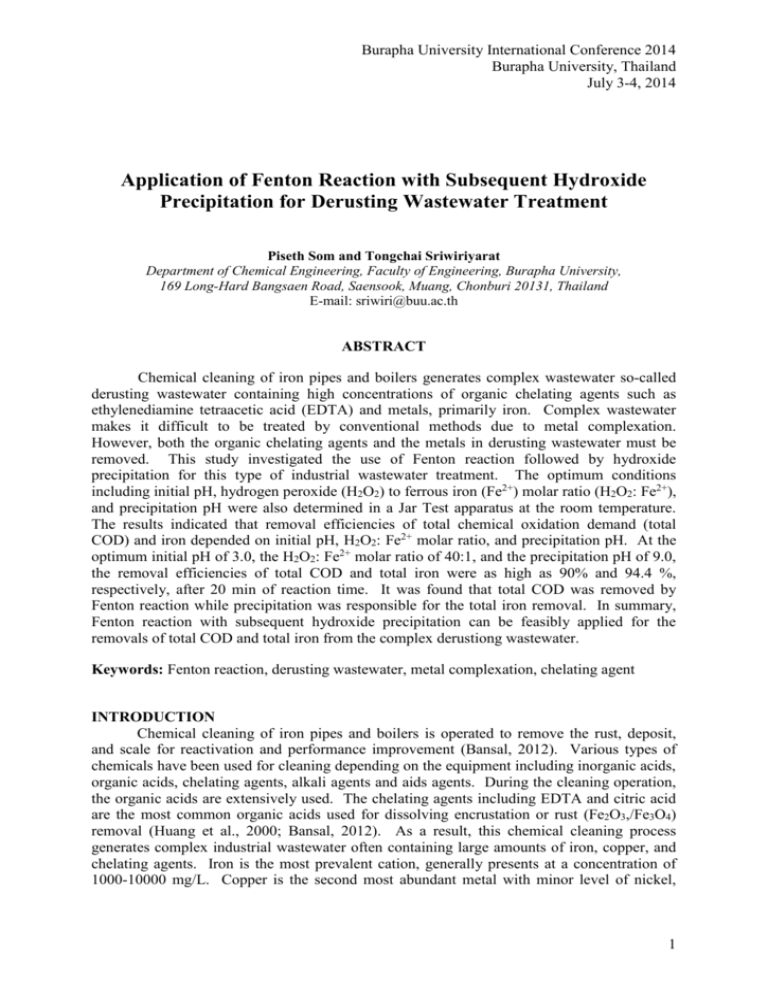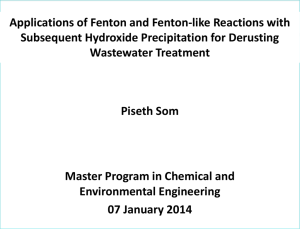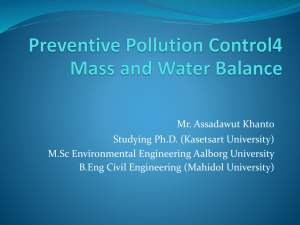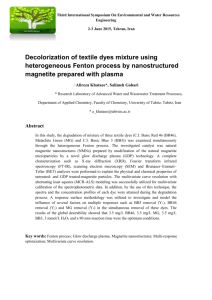File - Environmental Science and Engineering
advertisement

Burapha University International Conference 2014 Burapha University, Thailand July 3-4, 2014 Application of Fenton Reaction with Subsequent Hydroxide Precipitation for Derusting Wastewater Treatment Piseth Som and Tongchai Sriwiriyarat Department of Chemical Engineering, Faculty of Engineering, Burapha University, 169 Long-Hard Bangsaen Road, Saensook, Muang, Chonburi 20131, Thailand E-mail: sriwiri@buu.ac.th ABSTRACT Chemical cleaning of iron pipes and boilers generates complex wastewater so-called derusting wastewater containing high concentrations of organic chelating agents such as ethylenediamine tetraacetic acid (EDTA) and metals, primarily iron. Complex wastewater makes it difficult to be treated by conventional methods due to metal complexation. However, both the organic chelating agents and the metals in derusting wastewater must be removed. This study investigated the use of Fenton reaction followed by hydroxide precipitation for this type of industrial wastewater treatment. The optimum conditions including initial pH, hydrogen peroxide (H2O2) to ferrous iron (Fe2+) molar ratio (H2O2: Fe2+), and precipitation pH were also determined in a Jar Test apparatus at the room temperature. The results indicated that removal efficiencies of total chemical oxidation demand (total COD) and iron depended on initial pH, H2O2: Fe2+ molar ratio, and precipitation pH. At the optimum initial pH of 3.0, the H2O2: Fe2+ molar ratio of 40:1, and the precipitation pH of 9.0, the removal efficiencies of total COD and total iron were as high as 90% and 94.4 %, respectively, after 20 min of reaction time. It was found that total COD was removed by Fenton reaction while precipitation was responsible for the total iron removal. In summary, Fenton reaction with subsequent hydroxide precipitation can be feasibly applied for the removals of total COD and total iron from the complex derustiong wastewater. Keywords: Fenton reaction, derusting wastewater, metal complexation, chelating agent INTRODUCTION Chemical cleaning of iron pipes and boilers is operated to remove the rust, deposit, and scale for reactivation and performance improvement (Bansal, 2012). Various types of chemicals have been used for cleaning depending on the equipment including inorganic acids, organic acids, chelating agents, alkali agents and aids agents. During the cleaning operation, the organic acids are extensively used. The chelating agents including EDTA and citric acid are the most common organic acids used for dissolving encrustation or rust (Fe2O3,/Fe3O4) removal (Huang et al., 2000; Bansal, 2012). As a result, this chemical cleaning process generates complex industrial wastewater often containing large amounts of iron, copper, and chelating agents. Iron is the most prevalent cation, generally presents at a concentration of 1000-10000 mg/L. Copper is the second most abundant metal with minor level of nickel, 1 Burapha University International Conference 2014 Burapha University, Thailand July 3-4, 2014 chromium, and zinc, which typically present at the concentration less than 100 mg/L (Kim et al., 2010; Bansal, 2012). The organic chelating agent, EDTA, causes the complexation and immobilization of heavy metals. Indeed, metal-EDTA complexation is biologically persistent (Ghiselli et al., 2004; Chitra et al., 2011). Lime or caustic treatment, hydroxide precipitation, ion exchange are reported to be inhibited when metal existed as metal-EDTA complexes due to dramatically decrease of heavy metal solubility (Fu et al., 2009; Lan et al., 2012). Metal chelated wastewater has been treated by electrochemical reduction (Huang et al., 2000) and interior micro-electrolysis (Lan et al., 2012). Both processes can successfully remove metals; however, interior microelectrolysis cannot remove or degrade chelating EDTA. In addition, electrochemical reduction can achieve EDTA recovery for reuse. To remove metal and mineralize the metal-EDTA complexes, Fu et al. (2009; 2012) feasibly applied Fenton and Fenton-like reactions followed by hydroxide precipitation for synthetic Ni-EDTA complex wastewater. However, the real complex wastewater is suggested for further research; therefore, application of Fenton reaction for real derusting wastewater is of interest. For last few decades, advanced oxidation processes (AOPs) are known for destruction of a wide range of recalcitrant organic pollutants (Poyatos et al., 2010; Ameta et al., 2012). Among AOPs, Fenton process are adopted for wastewater treatment in terms of organic pollutant destruction, toxicity reduction, biodegradability improvement, COD, odor and color removals due to its economic advantage, ease of application, and effectiveness (Matthew Tarr, 2003; Bautista et al., 2008). Fe2+ + H2O2 → Fe3+ + OH• + OH− k = 70 M-1s-1 (1) RH + OH• → R•+ H2O k =107 -1010 M-1s-1 (2) R• + Fe3+ → R+ + Fe2+ - (3) Fe2++ OH• → Fe3++ OH− k = 3.2 108 M-1s-1 (4) H2O2 + OH•→ HO2• + H2O k =3.3 107 M-1s-1 (5) As shown in reaction (1), the ferrous iron (Fe2+) initiates and catalyses the decomposition of hydrogen peroxide (H2O2) to generate the hydroxyl radicals (OH•). The reaction (1) is commonly known as the main reaction of Fenton process (Neyens & Baeyens, 2003). The generated hydroxyl radical reacts immediately with organic substances (RH) resulting in a free organic radicals (R•) as indicated by reaction (2). These radicals are subsequently oxidized by ferric ion to generate other oxidation products as shown in reaction (3) (Matthew Tarr, 2003). In addition, ferrous iron and hydrogen peroxide are possibly involved with competitive or scavenging reactions with hydroxyl radicals as listed in reactions (4) and (5), respectively. This study discusses the feasibility of Fenton reaction for derusting wastewater monitored in terms of total COD and total iron removal efficiencies. Since the complex characteristics of the industrial wastewater, total COD represented all organic compound existed in wastewater. Total iron was the predominant metal in wastewater and used as objective parameter for this study. The objectives of the study were to investigate the effects of initial parameters of Fenton reaction including initial pH and H2O2 concentration for the treatment of derusting industrial wastewater and to determine the optimum precipitation pH after the Fenton reaction for the treatment of derusting wastewater. 2 Burapha University International Conference 2014 Burapha University, Thailand July 3-4, 2014 MATERIALS AND METHODS Derusting Wastewater The derusting wastewater used in this study was obtained from a cleaning service company located in Rayong Province, Thailand. The characteristics of the wastewater were provided in Table 1. Table 1. Characteristics of derusting wastewater used in the study Parameters Value Limited effluent pH 10.3 6.5-8.5 Total COD (mg/L) 22257 < 400 Total Iron (mg/L) 3920 < 0.5 3+ Ferric (Fe ) (mg/L) 3683 TDS (mg/L) 9840 < 5000 TSS (mg/L) 68 < 150 Conductivity (mS/cm) 19.7 The limited effluent is based on Thai industrial effluent standard in Pollution Control Department (PCD). www.pcd.go.th (Retrieved: September 20, 2013) Materials The following analytical-grade reagents including hydrogen peroxide (H2O2-35% w/w), ferrous sulfate (FeSO4-7H2O), manganese dioxide (MnO2), sodium hydroxide (NaOH), and sulfuric acid (H2SO4) were obtained from the Thai chemical supply company. The FeSO4 solution was prepared daily and used as a catalyst for the Fenton reaction. Deionized water (DI water) was used throughout the experiment. Analytical Methods The analytical methods for all parameters were analyzed according to the Standard Methods for the Examination of Water and Wastewater (APHA, 2005). Furthermore, the total COD and total iron were determined by the close reflux titrimetric method (Method 5520) and the phenanthroline method (Method 3500), respectively. A pH meter (EUTECH Model 510) was used to determine pH value of solution. Experimental Procedure The experiment was conducted by using a Jar Test apparatus (Model JR-6A, Metrology Technical, Co., Ltd., Thailand) equipped with six beakers of 1-L each under the room temperature (28 °C). Firstly, every beaker was added with 500 mL of wastewater taken from a large tank storing the industrial wastewater. The wastewater was mixing while the wastewater was transferred to the beakers so that the wastewaters in all beakers had the same characteristics. Subsequently, the wastewaters were mixed with 50 rpm mixing speed for a period of 15 min, and then adjusted with the H2SO4 (99.8% pure) to the pH value of 3.0. After that, the mixing speed was increased to 150 rpm and immediately added with 0.05 M of Fe2+ into the solutions. The Fe2+ concentration of 0.05 M was determined from another set of experiments. The solutions in all beakers were mixed for 15 min to allow homogenously dissolution of Fe2+. Subsequently, the mixing speed was decreased to 50 rpm and then 2 M of H2O2 was added. The Fenton reaction was taken place after the H2O2 was added. The Fenton reaction was allowed to proceed for a period of 60 min. At the end of Fenton reaction, 10 mL of sample was withdrawn from the beaker. A small amount of MnO2 was then added into the samples as a catalyst to decompose the remaining H2O2 to water and oxygen. The remaining H2O2 interfered with the COD measurement (Talinli, & Anderson, 1992). After Fenton 3 Burapha University International Conference 2014 Burapha University, Thailand July 3-4, 2014 reaction was completed, the Fenton treated effluents were continued for hydroxide precipitation by adjusting solution to alkaline pH value by the NaOH (10 N) and were mixed at the mixing speed of 150 rpm for a period of 15 min then allowed to precipitate for 30 min. Finally, the sample was collected from the supernatant for total COD and residue total iron determinations. The removal efficiency (R) was calculated by the following equation: R(%) AB x100 A (6) where A represents initial concentration of total COD or total iron B represents final concentration of total COD or total iron RESULTS AND DISCUSSION Effects of initial pH To examine the effects of initial pH on the total COD and iron removal efficiencies, the experiments were conducted at different initial pH of 2.0, 2.5, 3.0, 3.5 4.0, 4.5, 5.0, 6.0, and 7.0 with 2 M of H2O2 and 0.05 M of Fe2+. It is evident in Fig. 1 that Fenton reaction provided high reactivity at the pH ranged from 2.0 to 5.0 as reported in US Peroxide (2012). When pH increased from 2.0 to 3.0, the total COD and total iron removal efficiencies increased from 85.2 to 93.4% and from 90.5 to 92.1%, respectively. However, the total COD removal efficiency decreased from 91.9 to 25.9% with the increase of pH from 3.5 to 7.0 providing the optimum initial pH of 3.0. More importantly, the pH ranged from 6.0-7.0, the residue total iron concentration remained up to 4526 mg/L, which was greater than initial total iron concentration (3920 mg/L), leading to the negative removal efficiencies. Higher amount of iron in solution was resulted from the addition of 0.05 M Fe2+ as the catalyst for Fenton reaction. COD and Iron Removal Efficiencies, % 120 100 80 60 Total COD 40 Total Iron 20 0 0.0 -20 1.0 2.0 3.0 4.0 Initial pH 5.0 6.0 7.0 8.0 -40 Fig. 1. Effect of initial pH on the total COD and iron removal efficiencies at the H2O2 concentration of 2 M, the Fe2+ concentration of 0.05 M, the reaction time of 60 min, and the precipitation pH of 8.0 It is possibly to explain that lower removal efficiency of total COD at pH less than 3.0 is due to stabilization of H2O2 as oxonium ions (H3O2+). The reaction between OH• and H+ 4 Burapha University International Conference 2014 Burapha University, Thailand July 3-4, 2014 also occurs. In addition, Fe2+ regeneration by the reaction of Fe3+ with H2O2 is inhibited at more acidic pH value (Wang et al., 2011). The COD and iron removal efficiencies decreased at high pH (pH > 6) is a result of the Fe3+ precipitation as Fe(OH)3. Fe(OH)3 functionally catalyzes and decomposes H2O2 into O2 and H2O, providing less production of hydroxyl radical (OH•). Also, if the pH is too high ( pH> 5), self-decomposition of H2O2 into oxygen reduces its concentration in the solution (Bautista et al., 2008; Fu et al., 2009, 2012; Wang et al., 2011). The results from this experiment are in agreement with those studies reported by researchers (Neyens & Baeyens, 2003; Fu et al., 2009, 2012), who found that acidic pH level about 3.0 is usually optimum for Fenton reaction. Effects of H2O2:Fe2+ molar ratio In the Fenton process, the molar ratio of H2O2:Fe2+ is very important in terms of overall cost and removal efficiency of the process. Excessive or shortage of any of these two reagents results in the occurrence of scavenging reactions. Various molar ratios of H2O2: Fe2+ were applied to the industrial wastewaters with the optimum initial pH of 3.0. The effects of H2O2:Fe2+ on the removal efficiencies of total COD and iron are shown in Fig.2. The figure indicates that the removal efficiencies of both total COD and iron increased with the increase of the H2O2: Fe2+ molar ratios. COD and Iron Removal Efficiencies, % 120 Total COD Total Iron 100 80 60 40 20 0 0 10 20 30 H2O2 40 :Fe2+ 50 60 70 Ratio Fig. 2 Effects of H2O2:Fe2+ molar ratio on the total COD and iron removal efficiencies at the optimum initial pH of 3.0, the Fe2+ concentration of 0.05 M, the reaction time of 60 min, and the precipitation pH of 8. When the H2O2: Fe2+ molar ratio was 40, the total COD and total iron removal efficiencies were 93.0% and 90.5 %, respectively. However, further increase of H2O2:Fe2+ molar ratios above 40 did not enhance the removal efficiencies of both total COD and total iron due to quenching or scavenging effects reaction of hydroxyl radical by Fe2+ according to reaction 4. It should be noted that Fenton reaction requires high amount of H2O2 in the presence of EDTA in solution as previously reported by Ghiselli et al. (2004) and Fu et al. (2012). The optimum molar ratio of 40:1 in this study is comparatively lower than those studies reported in literatures (Ghiselli et al., 2004; Fu et al., 2009). Fu et al. (2009) have also reported that the detrimental effects may be observed when greater than 500:1 of H2O2: Fe2+ 5 Burapha University International Conference 2014 Burapha University, Thailand July 3-4, 2014 molar ratio is employed. However, in this study lower ratios were employed and detrimental effects has not been observed. Effects of precipitation pH The experiments were conducted to study the effects of precipitation pH on the total COD and total iron removal efficiencies. In this experiment, the total COD and iron removal efficiencies were analyzed in both Fenton treated effluent and precipitation treated effluent to investigate the extents of removal efficiency performed by individual process as shown in Fig.3. After the solution was treated by Fenton reaction, the treated solution pH was adjusted by adding hydroxide to form Fe(OH)3 precipitates as provided in the reactions (7)-(9) according to Fu et al., (2009). COD and Iron Removal Efficiencies, % 100 90 80 70 Total COD after Fenton Reaction Total COD after Precipitation Total Iron after Fenton Reaction Total Iron after Precipitation 60 50 40 30 20 10 0 5 6 7 8 9 Precipitation pH 10 11 12 Fig. 3 Effects of precipitation pH on the total COD and iron removal efficiencies at optimum initial pH of 3.0, Fe2+ concentration of 0.05M, H2O2 concentration of 2 M, and the reaction time of 20 min. The results indicated that about 15% of total iron was removed from the wastewater by the Fenton reactions. High concentration of iron in Fenton treated effluent may be resulted from low solution pH leading to high solubility of iron species (Fu et al., 2009; Lan et al., 2012). However, as shown in Fig. 3, with precipitation pH values increasing from 6.0 to 9.0, the removal efficiencies of total iron increased from 53.6 % to 94.4 % after 20 min of reaction time. When pH increased further, the removal efficiencies were unchanged because the iron precipitates as Fe(OH)3 at very high pH (Fu et al.,2009). This is apparently explained that at the pH lower than 8.0, solubility and concentration of dissolved Fe2+ and Fe3+ remains high in solution. However, when pH of solution is greater than 8.0, fraction of Fe2+ and Fe3+ are in solid phase or form Fe(OH)2 and Fe(OH)3 as precipitates as shown in reactions below (Morgan & Lahav, 2007; Fu et al., 2009). On the other hand, removal efficiencies of COD remained almost unchanged (R = 90%) after Fenton reaction and precipitated in all pH values. Organic degradation or total COD removal was accomplished by Fenton reaction before precipitation process. Fe2+ + 2OH− → Fe(OH)2↓ (7) 6 Burapha University International Conference 2014 Burapha University, Thailand July 3-4, 2014 4Fe(OH)2 + O2 + 2H2O → 4Fe(OH)3↓ Fe3+ + 3OH− → Fe(OH)3↓ (8) (9) In summary, precipitation does not improve the removal efficiency in terms of total COD reduction; however, it is responsible for iron precipitation found in this study. As reported, Fenton reaction is employed for organic degradation while the alkaline range of pH is to stop Fenton reaction and precipitate irons (Lan et al., 2012; USperoxide, 2012). ACKNOWLEDGEMENTS The authors would like to thank the Research and Development Fund for Cooperation Promotion with External Organizations of the Faculty of Engineering, Burapha University (Contract No. 9/2556) and Kation Power, Co., Ltd. for financial supports. The authors are also grateful for teaching assistance of Silchai Kuhakeaw and laboratory assistances of undergraduate students including Siraprapa Pandaeng, Paphada Jirachonrat, Siwarin Thongroe, and Prapromporn Klaichit. REFERENCES Ameta, R., Kumar, A., Punjabi, P. B., & Ameta, S. C. (2012). Advanced Oxidation Processes: Basics and Applications. Wastewater Treatment: Advanced Processes and Technologies. APHA, A. (2005). Standard methods for the examination of water and wastewater American Public Health Association. Inc., Washington. DC. Bansal, N. K. (2012). Chemical Analysis during Chemical Cleaning of Boiler Using EDTA. Bautista, P., Mohedano, A. F., Casas, J. A., Zazo, J. A., & Rodriguez, J. J. (2008). An overview of the application of Fenton oxidation to industrial wastewaters treatment. Journal of Chemical Technology & Biotechnology, 83(10), 1323–1338. Chitra, S., Paramasivan, K., & Sinha, P. K. (2011). Photodegradation of EDTA using Fenton’s reagent: a pilot-scale study. Research on Chemical Intermediates, 37(8), 961–974. Fu, F., Wang, Q., & Tang, B. (2009). Fenton and Fenton-like reaction followed by hydroxide precipitation in the removal of Ni(II) from NiEDTA wastewater: A comparative study. Chemical Engineering Journal, 155(3), 769–774. Fu, F., Xie, L., Tang, B., Wang, Q., & Jiang, S. (2012). Application of a novel strategy— Advanced Fenton-chemical precipitation to the treatment of strong stability chelated heavy metal containing wastewater. Chemical Engineering Journal, 189–190, 283– 287. Ghiselli, G., Jardim, W. F., Litter, M. I., & Mansilla, H. D. (2004). Destruction of EDTA using Fenton and photo-Fenton-like reactions under UV-A irradiation. Journal of Photochemistry and Photobiology A: Chemistry, 167(1), 59–67. Huang, C., Hsu, M., & Miller, P. (2000). Recovery of EDTA from Power Plant Boiler Chemical Cleaning Wastewater. Journal of Environmental Engineering, 126(10), 919–924. Kim, H.-S., Lee, W.-S., Ahn, C.-Y., Kim, B.-H., Kim, J.-E., & Oh, H.-M. (2010). Kinetic correlation between degradation and dechlorination of perchloroethylene in the Fenton reaction. Korean Journal of Chemical Engineering, 27(6), 1750–1754. Lan, S., Ju, F., & Wu, X. (2012). Treatment of wastewater containing EDTA-Cu(II) using the combined process of interior microelectrolysis and Fenton oxidation–coagulation. Separation and Purification Technology, 89, 117–124. 7 Burapha University International Conference 2014 Burapha University, Thailand July 3-4, 2014 Matthew Tarr. (2003). Fenton and Modied Fenton Methods for Pollutant Degradation. In Chemical Degradation Methods for Wastes and Pollutants:Environmental and Industrial Applications (Vols. 1-0). CRC Press. Morgan, B., & Lahav, O. (2007). The effect of pH on the kinetics of spontaneous Fe(II) oxidation by O2 in aqueous solution – basic principles and a simple heuristic description. Chemosphere, 68(11), 2080–2084. Neyens, E., & Baeyens, J. (2003). A review of classic Fenton’s peroxidation as an advanced oxidation technique. Journal of Hazardous Materials, 98(1–3), 33–50. Poyatos, J. M., Muñio, M. M., Almecija, M. C., Torres, J. C., Hontoria, E., & Osorio, F. (2010). Advanced Oxidation Processes for Wastewater Treatment: State of the Art. Water, Air, and Soil Pollution, 205(1-4), 187–204. Talinli, L. & Anderson, G.K. (1992). Interference of hydrogen peroxide on the standard COD test. Water Research, 26(1), 107-110. US Peroxide. (2012). General Chemistry of Fenton's Reagent. Retrieved July 18, 2013, from http://www.h2o2.com/industrial/fentons-reagent Wang, Z., Chen, K., Li, J., Mo, L., & Wang, Q. (2011). The removal of COD from bleaching effluents by Fenton’s reagent: Effect of system parameters and kinetic study. Environmental Progress & Sustainable Energy, 30(2), 168–176. 8








